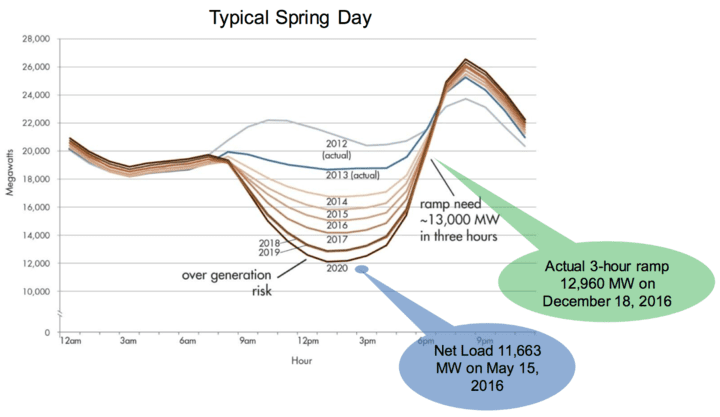Because That’s Where the Carbon Is!
 Hybrid generation and storage is key to rapid low-carbon transition.
Hybrid generation and storage is key to rapid low-carbon transition.COMMENTARY
When asked why he robbed banks, the infamous Willie Sutton is said to have replied, Because that's where the money is!" So, when trying to decarbonize California's electric power sector, we should follow Sutton's Law and focus on where the carbon is.
To decarbonize, California has relied on increasing the amount of renewable generation (wind and solar) by means of the Renewable Portfolio Standard (RPS). The RPS program sets continually escalating renewable energy procurement requirements for the state's load-serving entities. It began in 2002 with a 2017 target of 20%, and now mandates 44% by 2024, 52% by 2027, and 60% by 2030.
Yet, as shown by the black line in Figure 1, CO2 emissions have stopped decreasing and seem to have plateaued at about 260 grams per kilowatt-hour (g/kWh). Despite increasing the share of renewable energy, it's clear that the RPS method is no longer an effective means of reducing CO2.
 1. California emission rates have become increasingly volatile as the renewable portfolio has increased, yet average emissions have not been reduced significantly. Source: Electricity Maps
1. California emission rates have become increasingly volatile as the renewable portfolio has increased, yet average emissions have not been reduced significantly. Source: Electricity MapsThe blue curve shows the range of hourly CO2 emissions that make up the average. During peak renewable hours, emissions can be less than 100 g/kWh, but when renewables are not available, the emissions rate is much higher-often exceeding 350 g/kWh. Especially notable is the increased volatility of emissions that reflects the need to rely on the least efficient gas-fired generators.
California's Duck Curve" (Figure 2) illustrates the grid challenge of instantaneously balancing supply and demand as the production of renewable power varies throughout the day. Renewables require flexible generation that can quickly ramp up and down and provide reliable power when the sun and wind are not available.
 2. The Duck Curve shows the need for flexible generation to back up renewables. Source: California Independent System Operator (CAISO)
2. The Duck Curve shows the need for flexible generation to back up renewables. Source: California Independent System Operator (CAISO)Currently, California uses two primary types of gas-fired generation for flexibility and renewable backup:
- Simple cycle gas turbines (SCGTs) can quickly start up and reach full power to rapidly balance waning renewable energy. At full power, modern units have a fuel efficiency of about 38%, which corresponds to a CO2 emissions rate of 480 g/kWh, but efficiency falls when operated at part load to balance renewable variability.
- Combined cycle gas turbines (CCGTs) are the most fuel-efficient power plants because they harvest gas turbine waste heat to operate a steam turbine generator. These plants can achieve a fuel efficiency of more than 50%, reducing CO2 emissions to about 366 g/kWh. However, during the several hours it takes to start the steam system, fuel efficiency can be quite low, and emissions per kWh very high. To be able to respond to the ramp, many CCGTs operate at their minimum power (Pmin), at lower efficiency. Ironically this can also force renewables off-line to increase overall emissions and electricity prices.
Although batteries can address the ramping needs, they are too expensive to provide the longer durations needed overnight, during extended periods of cloudy and calm weather, or during extreme events like wildfires.
Fortunately, a low-cost, long-duration hybrid energy storage solution is available now to cut CO2 emissions to 250 g/kWh or less while addressing the Duck Curve: the Liquid Salt Combined Cycle (LSCC), which combines proven, low-cost thermal energy storage with gas turbines. When renewables are abundant and CO2 emissions are low, molten salt is electrically heated to store clean energy; later the hot salt is used to make low-carbon power.
Not only is the LSCC more fuel-efficient than the combined cycle but the stored energy can preheat the steam cycle so the system can start quickly, like a simple cycle. Instead of running a combined cycle at Pmin and curtailing renewables, LSCC uses renewables to reduce CO2 emissions.
California should follow the bank robber's lead and focus directly on emissions by modifying the gas-fired thermal fleet with LSCC as a practical, cost-effective, and realistic way to cut CO2 and restore RPS as an effective instrument for cutting emissions. As expensive hydrogen replaces natural gas to meet California's zero-carbon goals, LSCC's superior fuel efficiency will reduce electricity costs compared to existing gas generation.
-William M. Conlon, PE, PhD is president of Pintail Power LLC.
The post Because That's Where the Carbon Is! appeared first on POWER Magazine.